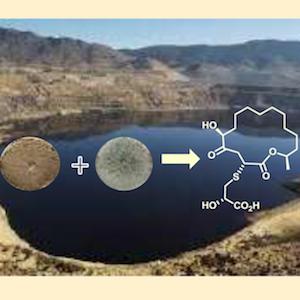Microbiologists often study microbes in isolation. In the scientific vernacular, this is called "pure culture." While this is necessary to understand how individual microbes work, the trouble with this approach is that microbes do not live by themselves in the natural environment. Instead, they live in communities with multiple other species, cooperating and competing in order to survive.
As a result, microbes can behave very differently in the environment compared to the artificial solitude of the laboratory. This insight has helped spur the field of microbial ecology, which studies microbial interactions with each other and the environment. One technique to do is "co-culture." Instead of growing microbes in isolation, they are grown in the presence of other organisms.
A team of scientists led by Andrea Stierle from the University of Montana has applied this technique to species of the fungus Penicillium, the same genus that produces the antibiotic penicillin. The researchers discovered that, when grown in co-culture, two different species of the fungus cooperate to synthesize an antibiotic that neither species produces when grown alone.
The species, called P. fuscum and P. camembertii/clavigerum, are extremophiles (i.e., microbes that love extreme environmental conditions) that the team isolated from the Berkeley Pit Lake, which is acidic and metal-rich. The fungi were grown in separate pure cultures as well as in co-culture, after which metabolites were extracted, isolated, and identified. The team noticed that unique molecules were present in co-culture that weren't found in the pure cultures.
One such molecule had the chemical formula C19H32O7S and was named Berkeleylactone A. The molecule exhibited potent antibiotic activity. Berkeleylactone A could block the growth of several Gram-positive bacteria, like MRSA (methicillin-resistant Staphylococcus aureus) as well as the bacteria that cause strep throat (Streptococcus pyogenes) and anthrax (Bacillus anthracis). In fact, it was better at blocking MRSA than a whole panel of common antibiotics, such as erythromycin, doxycycline, and clindamycin. It was not active, however, against Gram-negative bacteria (such as E. coli).
It's not yet clear how these fungi cooperate to produce Berkeleylactone A. It is possible that one of the fungi produces it all by itself, but requires a chemical trigger from the other fungus. Likewise, it is possible that one fungus secretes a precursor molecule which is subsequently modified by the other.
Regardless of the exact mechanism, such "cryptic biosynthetic" pathways have enormous potential to provide biomedical science with a new arsenal of weapons against antibiotic-resistant bacteria.
Source: Andrea A. Stierle, et al. "The Berkeleylactones, Antibiotic Macrolides from Fungal Coculture." J Nat Prod 80(4): 1150-1160. Published: 22-Mar-2017. DOI: 10.1021/acs.jnatprod.7b00133




